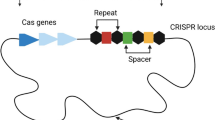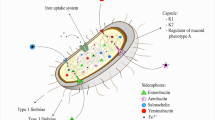Abstract
Earlier, we reported that ST239 was the 15-year predominant methicillin-resistant Staphylococcus aureus (MRSA) clone in China. In this study, MRSA strain CN79 belonging to ST239 and isolated from blood was used to determine the whole genome sequence. Comparative genomics analysis was done between MRSA CN79 and 25 sequenced S. aureus in the NCBI GenBank database. A total of 2,734 protein-encoding genes were identified in the MRSA CN79 genome, which carries 11 antibiotic resistance genes and 65 virulence genes. Two prophages phiCN79A and phiNM3-like were found on the MRSA CN79 genome. MRSA CN79 carries 30 specific genes that are absent from the 25 sequenced S. aureus genomes. Most of them were prophage-related genes. Several antibiotic resistance genes, such as β-lactamase and ABC-type multidrug transport system gene, were located on the genomic island νSaβ. The antibiotic resistance genes, such as tet (M), ermA1, and blaZ, were also located on different transposons. The virulence genes sea, map, hlb, and sak are located on phiNM3-like prophage and the exotoxin genes are carried on the genomic island νSaα. These results suggest that ST239 MRSA strains are widespread owing to horizontal acquisition of the mobile genetic elements harbored antibiotic resistance genes and virulence genes in response to environmental selective pressures, such as antibiotics and the human immune system during evolution.




Similar content being viewed by others
References
Wang H, Liu Y, Sun H et al (2008) In vitro activity of ceftobiprole, linezolid, tigecycline, and 23 other antimicrobial agents against Staphylococcus aureus isolates in China. Diagn Microbiol Infect Dis 62:226–229
Sun W, Chen H, Liu Y et al (2009) Prevalence and characterization of heterogeneous vancomycin-intermediate Staphylococcus aureus isolates from 14 cities in China. Antimicrob Agents Chemother 53:3642–3649
Wang SH, Khan Y, Hines L et al (2012) Methicillin-resistant Staphylococcus aureus sequence type 239-III, Ohio, USA, 2007–2009. Emerg Infect Dis 18:1557–1565
Song JH, Hsueh PR, Chung DR et al (2011) Spread of methicillin-resistant Staphylococcus aureus between the community and the hospitals in Asian countries: an ANSORP study. J Antimicrob Chemother 66:1061–1069
Jackson CR, Davis JA, Barrett JB (2013) Prevalence and characterization of methicillin-resistant Staphylococcus aureus isolates from retail meat and humans in Georgia. J Clin Microbiol 51:1199–1207
Teixeira LA, Resende CA, Ormonde LR et al (1995) Geographic spread of epidemic multiresistant Staphylococcus aureus clone in Brazil. J Clin Microbiol 33:2400–2404
Corso A, Santos Sanches I, Aires de Sousa M et al (1998) Spread of a methicillin-resistant and multiresistant epidemic clone of Staphylococcus aureus in Argentina. Microb Drug Resist 4:277–288
Aires De Sousa M, Miragaia M, Sanches IS et al (2001) Three-year assessment of methicillin-resistant Staphylococcus aureus clones in Latin America from 1996 to 1998. J Clin Microbiol 39:2197–2205
Aires de Sousa M, Sanches IS, Ferro ML et al (1998) Intercontinental spread of a multidrug-resistant methicillin-resistant Staphylococcus aureus clone. J Clin Microbiol 36:2590–2596
Melter O, Santos Sanches I, Schindler J et al (1999) Methicillin-resistant Staphylococcus aureus clonal types in the Czech Republic. J Clin Microbiol 37:2798–2803
Aires de Sousa M, Bartzavali C, Spiliopoulou I et al (2003) Two international methicillin-resistant Staphylococcus aureus clones endemic in a university hospital in Patras, Greece. J Clin Microbiol 41:2027–2032
Delgado A, Riordan JT, Lamichhane-Khadka R et al (2007) Hetero-vancomycin-intermediate methicillin-resistant Staphylococcus aureus isolate from a medical center in Las Cruces. New Mexico. J Clin Microbiol 45:1325–1329
Kuroda M, Ohta T, Uchiyama I et al (2001) Whole genome sequencing of meticillin-resistant Staphylococcus aureus. Lancet 357:1225–1240
Feng Y, Chen CJ, Su LH et al (2008) Evolution and pathogenesis of Staphylococcus aureus: lessons learned from genotyping and comparative genomics. FEMS Microbiol Rev 32:23–37
Chen H, Liu Y, Jiang X et al (2010) Rapid change of methicillin-resistant Staphylococcus aureus clones in a Chinese tertiary care hospital over a 15-year period. Antimicrob Agents Chemother 54:1842–1847
Li R, Li Y, Kristiansen K et al (2008) SOAP: short oligonucleotide alignment program. Bioinformatics 24:713–714
Aziz RK, Bartels D, Best AA et al (2008) The RAST Server: rapid annotations using subsystems technology. BMC Genom 9:75
Bose M, Barber RD (2006) Prophage Finder: a prophage loci prediction tool for prokaryotic genome sequences. In Silico Biol 6:223–227
Siguier P, Perochon J, Lestrade L et al (2006) ISfinder: the reference centre for bacterial insertion sequences. Nucleic Acids Res 34:D32–D36
Darling AE, Mau B, Perna NT (2010) progressiveMauve: multiple genome alignment with gene gain, loss and rearrangement. PLoS One 5:e11147
Xu Z, Hao B (2009) CVTree update: a newly designed phylogenetic study platform using composition vectors and whole genomes. Nucleic Acids Res 37:W174–W178
Liu B, Pop M (2009) ARDB—Antibiotic Resistance Genes Database. Nucleic Acids Res 37:D443–D447
Chen L, Xiong Z, Sun L et al (2012) VFDB 2012 update: toward the genetic diversity and molecular evolution of bacterial virulence factors. Nucleic Acids Res 40:D641–D645
Rouch DA, Cram DS, DiBerardino D et al (1990) Efflux-mediated antiseptic resistance gene qacA from Staphylococcus aureus: common ancestry with tetracycline- and sugar-transport proteins. Mol Microbiol 4:2051–2062
Tanaka M, Wang T, Onodera Y et al (2000) Mechanism of quinolone resistance in Staphylococcus aureus. J Infect Chemother 6:131–139
Cui L, Neoh HM, Shoji M et al (2009) Contribution of vraSR and graSR point mutations to vancomycin resistance in vancomycin-intermediate Staphylococcus aureus. Antimicrob Agents Chemother 53:1231–1234
Zmantar T, Chaieb K, Makni H et al (2008) Detection by PCR of adhesins genes and slime production in clinical Staphylococcus aureus. J Basic Microbiol 48:308–314
Patti JM, Jonsson H, Guss B et al (1992) Molecular characterization and expression of a gene encoding a Staphylococcus aureus collagen adhesin. J Biol Chem 267:4766–4772
Downer R, Roche F, Park PW et al (2002) The elastin-binding protein of Staphylococcus aureus (EbpS) is expressed at the cell surface as an integral membrane protein and not as a cell wall-associated protein. J Biol Chem 277:243–250
Josefsson E, McCrea KW, Ní Eidhin D et al (1998) Three new members of the serine-aspartate repeat protein multigene family of Staphylococcus aureus. Microbiology 144:3387–3395
Cheng AG, Kim HK, Burts ML et al (2009) Genetic requirements for Staphylococcus aureus abscess formation and persistence in host tissues. FASEB J 23:3393–3404
Tung HS, Guss B, Hellman U et al (2000) A bone sialoprotein-binding protein from Staphylococcus aureus: a member of the staphylococcal Sdr family. Biochem J 345:611–619
Sitkiewicz I, Babiak I, Hryniewicz W (2011) Characterization of transcription within sdr region of Staphylococcus aureus. Antonie Van Leeuwenhoek 99:409–416
Torres VJ, Pishchany G, Humayun M et al (2006) Staphylococcus aureus IsdB is a hemoglobin receptor required for heme iron utilization. J Bacteriol 188:8421–8429
Voyich JM, Otto M, Mathema B et al (2006) Is Panton-Valentine leukocidin the major virulence determinant in community-associated methicillin-resistant Staphylococcus aureus disease? J Infect Dis 194:1761–1770
Lee LY, Miyamoto YJ, McIntyre BW et al (2002) The Staphylococcus aureus Map protein is an immunomodulator that interferes with T cell-mediated responses. J Clin Invest 110:1461–1471
Donegan NP, Thompson ET, Fu Z et al (2010) Proteolytic regulation of toxin–antitoxin systems by ClpPC in Staphylococcus aureus. J Bacteriol 192:1416–1422
Rice K, Peralta R, Bast D et al (2001) Description of staphylococcus serine protease (ssp) operon in Staphylococcus aureus and nonpolar inactivation of sspA-encoded serine protease. Infect Immun 69:159–169
Bokarewa MI, Jin T, Tarkowski A (2006) Staphylococcus aureus: staphylokinase. Int J Biochem Cell Biol 38:504–509
Acknowledgments
This work was supported, in part, by the Beijing Natural Science Foundation (7102130), the Program for New Century Excellent Talents in University (NCET-10-0205), the National Natural Science Foundation of China (31100106) and Key Projects in the National Science & Technology Pillar Program (2012EP001002). The authors thank International Science Editing for polishing the manuscript.
Author information
Authors and Affiliations
Corresponding authors
Additional information
Hongbin Chen and Xi Yang contributed equally to this work.
About this article
Cite this article
Chen, H., Yang, X., Wang, Q. et al. Insights on evolution of virulence and resistance from the whole-genome analysis of a predominant methicillin-resistant Staphylococcus aureus clone sequence type 239 in China. Chin. Sci. Bull. 59, 1104–1112 (2014). https://doi.org/10.1007/s11434-014-0149-1
Received:
Accepted:
Published:
Issue Date:
DOI: https://doi.org/10.1007/s11434-014-0149-1




